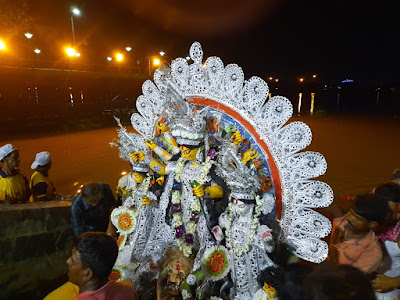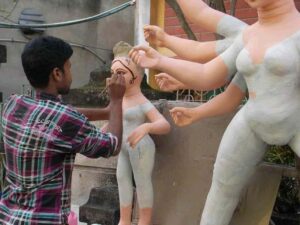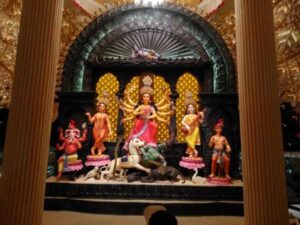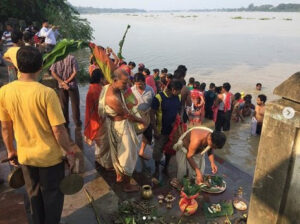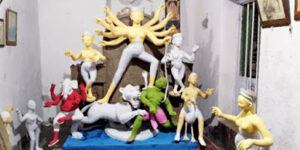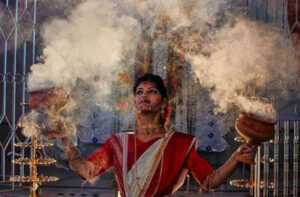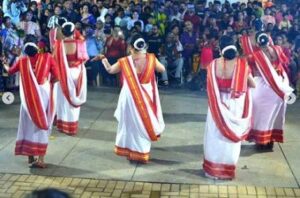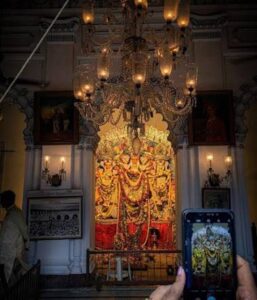Sindoor Khela, the colorful ritual, is one of the most important events of Durga Puja. The literal meaning of Sindoor Khela is playing with vermilion. It is celebrated on the Vijaya Dashami, the last day of Durga Puja. The custom holds vital significance in the life of married Bengali Hindu women. Through this, they pray for the long and happy married lives of each other.
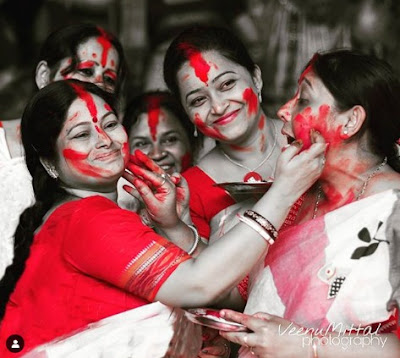 |
Sindoor Khela Pic Credits – Veenu Mittal |
Bengalis worship the Goddess Durga in the form of the daughter. On the day of Mahalaya, the ritual of Chokku Dan (drawing the eyes of the idol) is performed. That marks the beginning of her journey from her abode, Mount Kailasha, to her maternal home on earth. She is accompanied by her children Karthik, Saraswati, Ganesha, and Laxmi. On the day of Vijaya Dashmi, she returns to her husband’s home.
Before bidding farewell to the Goddess, married women follow the ritual of Debi Boron. They place the Boron items, sindoor, Alta, betel leaves, betel nuts(Supari), incense sticks, coin, and sweets(Sondesh) on a plate.
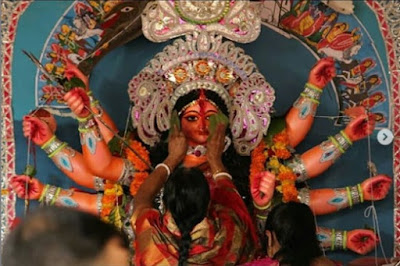 |
Debi Boron Pic Credits – Instagram/the.bongbalika |
First, they clean the deity’s face with betel leaf in both their hands to make sure that the Goddess does not leave with tearful eyes. Betel leaves or Paan also signifies the auspiciousness of the occasion.
Then, they apply Sindur on the forehead and feet of Maa Durga and offer sweets to the Goddess. The coin is touched to the feet of the Goddess, and it is considered Lucky.
The same rituals follow for Goddess Saraswati, Goddess Laxmi, and Kolabou (Ganesh’s wife). Sweets are offered to Lord Karthik and Ganesha. After this, the ladies smear Sindur on each other’s forehead and faces. They also touch sindoor to each other’s Shankha, Pola, and Noa(iron bangle), the traditional bangles worn by Bengali women. They also offer sweets to each other. The women keep the residual sindoor for their daily use.
Also Read: Shakha Pola Traditional Bengali Bangles Origin, History, And Significance
On Dashami, another ritual called Prasasthi Vandana is followed. A mirror is positioned before Maa Durga. Devotees form a queue and one by one look into the mirror to get a glimpse of the Goddess’s feet. To catch a glimpse of her feet is said to have a prosperous effect on someone’s life. The mirror is also symbolic in the sense that whenever there is a ritual bathing of Goddess Durga, it is the reflection on the mirror that is bathed and not the original Deity.
The view of Debi Boron is quite spectacular. The married women, all dressed in traditional white saris with red borders or full red saree patiently waiting in a queue to bid their final goodbye to the Goddess. In the background, the beats of Dhak amplifies the mood. Women are also seen dancing in a group on the rhythms of Dhak.
Also Read: Bengali Dhaki Amplifies The Festive Mood During Durga Puja
This vibrant custom dates back to some centuries ago in the Rajbaris to usher in the bonhomie among the housewives. This day women forget the petty quarrels and animosities. All happy faces smeared with sindoor wish for each other’s prosperity. It is believed that more amount of sindoor on a woman’s face means she will have a long-married life.
